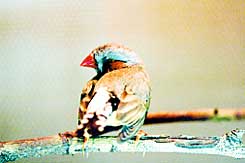It is possible that the brain activity of songbirds during sleep is similar to that of mammals

A songbird from the Pharisee group. with and without rapid eye movements. Photo: University of Chicago
Direct link to this page: https://www.hayadan.org.il/zipporhalom.html
The traits that were once thought to distinguish humans from other animals have begun to emerge in the last hundred years in non-human contexts. It turned out that crows use tools, that parrots know how to count, and that dolphins and chimpanzees demonstrate cunning if not cheating for its own sake.
In a similar way, it was common to think that mammals are different from other animals because their brains contain the most developed part of the brain - the cerebral cortex. Thus, it used to be thought, only mammals experience rapid eye movement (REM) sleep and non-rapid eye movement (non-REM) sleep. During REM sleep known as "dream sleep" the eyes are closed and move quickly and the electrical activity in the brain is characterized by high frequency and low amplitude. On the other hand, in non-REM sleep (known as "dreamless sleep") the electrical signals are of low frequency and high amplitude. The third sleep pattern characteristic of mammals is an intermediate stage, between REM and non-REM
Now new findings presented at the annual meeting of the Society for Neuroscience in New Orleans suggest that some birds have sleep patterns similar to those of mammals. Philip Lowe, an advanced graduate student at the Salk Institute for Biological Studies in California, and researchers from the University of Chicago discovered that songbirds experience REM sleep, non-REM sleep, and an intermediate stage - just like humans. In addition, at night, as the hours pass, the songbirds' brains get longer and REM sleep appears more frequently, similar to the process that occurs in the brains of mammals.
There is no dispute that songbirds, which are among the most highly developed birds, do not have a cerebral cortex. However, there are scientists who claim that in the brains of these birds there are areas that allow the performance of some of the functions for which the cerebral cortex is responsible in mammals. Lowe and his colleagues claim that the cerebral cortex is not necessary for the existence of the sleep patterns characteristic of mammals.
Lowe and his colleagues recorded the electrical activity in the brains of birds of the Prussian group while they slept and followed the eye movements of the birds using infrared cameras. They found that the three stages of sleep known in mammals also characterize the sleeping pharaohs. The scientists also noticed some "exotic signals" in the intermediate stage, very similar to a pattern of electrical activity that until now was considered a hallmark of a mammalian sleep. Understanding these signals will require further studies.
The findings, which have not yet been published, appear to be controversial, as other groups of researchers have failed to detect REM sleep in Pharisees. But the findings of Lowe and his colleagues seem to be supported by the findings of a large study of bird brains conducted by Andrew Ivanyuk, a psychologist at Clayton University in Australia. Ivanyuk and his collaborators collected information on the structure and size of bird brains in more than 1,400 species, including more than 150 species of parrots. The goal was to compare the brain development, social behavior and intellectual capacity of the birds to those of primates.
In the first stages, the research focused on the insiders, due to their famous intellectual skills. So far, researchers have discovered that the ratio between the size of different areas of the brain and the size of the body is similar in birds and primates. The similarity is particularly striking in the areas responsible for complex mental tasks. Some parrots even have larger brains than primates of the same weight.
Another interesting finding, according to Dr. Ivaniuk, is that in some songbirds the relative size of the front part of the brain is similar to that of mammals. Based on these findings and Lowe's findings, Ivaniuk makes two claims: first, that previous studies on the sleep patterns of birds were flawed and that many birds other than parrots experience REM sleep and non-REM sleep; and second, that it is possible that many birds have impressive cognitive abilities similar to parrots.
They know evolution in action
https://www.hayadan.org.il/BuildaGate4/general2/data_card.php?Cat=~~~699395475~~~196&SiteName=hayadan
